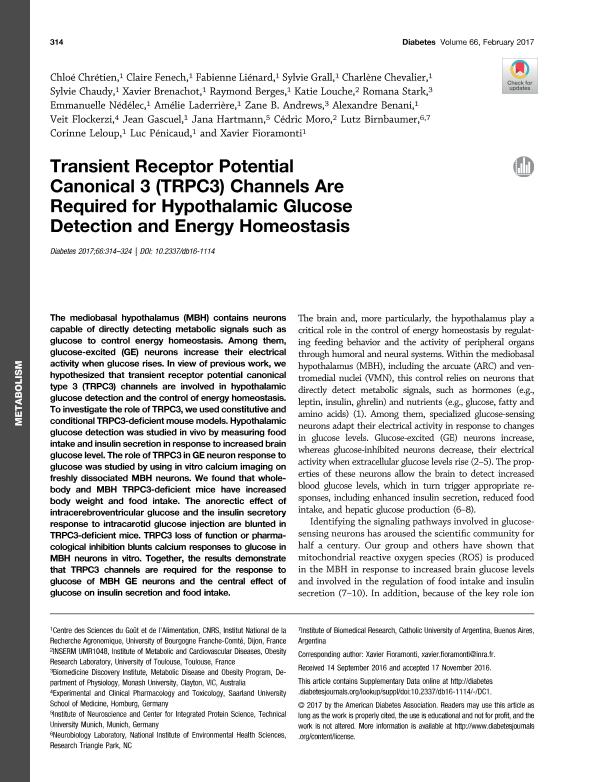Mostrar el registro sencillo del ítem
dc.contributor.author
Chrétien, Chloé
dc.contributor.author
Fenech, Claire
dc.contributor.author
Liénard, Fabienne
dc.contributor.author
Grall, Sylvie
dc.contributor.author
Chevalier, Charlène
dc.contributor.author
Chaudy, Sylvie
dc.contributor.author
Brenachot, Xavier
dc.contributor.author
Berges, Raymond
dc.contributor.author
Louche, Katie
dc.contributor.author
Stark, Romana
dc.contributor.author
Nédélec, Emmanuelle
dc.contributor.author
Laderrière, Amélie
dc.contributor.author
Andrews, Zane B.
dc.contributor.author
Benani, Alexandre
dc.contributor.author
Flockerzi, Veit
dc.contributor.author
Gascuel, Jean
dc.contributor.author
Hartmann, Jana
dc.contributor.author
Moro, Cédric
dc.contributor.author
Birnbaumer, Lutz

dc.contributor.author
Leloup, Corinne
dc.contributor.author
Pénicaud, Luc
dc.contributor.author
Fioramonti, Xavier
dc.date.available
2018-08-13T16:57:44Z
dc.date.issued
2017-02
dc.identifier.citation
Chrétien, Chloé; Fenech, Claire; Liénard, Fabienne; Grall, Sylvie; Chevalier, Charlène; et al.; Transient receptor potential canonical 3 (TRPC3) channels are required for hypothalamic glucose detection and energy homeostasis; American Diabetes Association; Diabetes; 66; 2; 2-2017; 314-324
dc.identifier.issn
0012-1797
dc.identifier.uri
http://hdl.handle.net/11336/55131
dc.description.abstract
The mediobasal hypothalamus (MBH) contains neurons capable of directly detecting metabolic signals such as glucose to control energy homeostasis. Among them, glucose-excited (GE) neurons increase their electrical activity when glucose rises. In view of previous work, we hypothesized that transient receptor potential canonical type 3 (TRPC3) channels are involved in hypothalamic glucose detection and the control of energy homeostasis. To investigate the role of TRPC3, we used constitutive and conditional TRPC3-deficientmouse models. Hypothalamic glucose detection was studied in vivo by measuring food intake and insulin secretion in response to increased brain glucose level. The role of TRPC3 in GE neuron response to glucose was studied by using in vitro calcium imaging on freshly dissociated MBH neurons. We found that wholebody and MBH TRPC3-deficient mice have increased body weight and food intake. The anorectic effect of intracerebroventricular glucose and the insulin secretory response to intracarotid glucose injection are blunted in TRPC3-deficient mice. TRPC3 loss of function or pharmacological inhibition blunts calcium responses to glucose in MBH neurons in vitro. Together, the results demonstrate that TRPC3 channels are required for the response to glucose of MBH GE neurons and the central effect of glucose on insulin secretion and food intake.
dc.format
application/pdf
dc.language.iso
eng
dc.publisher
American Diabetes Association

dc.rights
info:eu-repo/semantics/openAccess
dc.rights.uri
https://creativecommons.org/licenses/by-nc-sa/2.5/ar/
dc.subject
Trpc3
dc.subject
Hypothalamic Glucose Sensing
dc.subject
Diabetes
dc.subject.classification
Inmunología

dc.subject.classification
Medicina Básica

dc.subject.classification
CIENCIAS MÉDICAS Y DE LA SALUD

dc.title
Transient receptor potential canonical 3 (TRPC3) channels are required for hypothalamic glucose detection and energy homeostasis
dc.type
info:eu-repo/semantics/article
dc.type
info:ar-repo/semantics/artículo
dc.type
info:eu-repo/semantics/publishedVersion
dc.date.updated
2018-06-07T14:09:03Z
dc.journal.volume
66
dc.journal.number
2
dc.journal.pagination
314-324
dc.journal.pais
Estados Unidos

dc.journal.ciudad
Nueva York
dc.description.fil
Fil: Chrétien, Chloé. University of Bourgogne Franche-Comté; Francia
dc.description.fil
Fil: Fenech, Claire. University of Bourgogne Franche-Comté; Francia
dc.description.fil
Fil: Liénard, Fabienne. University of Bourgogne Franche-Comté; Francia
dc.description.fil
Fil: Grall, Sylvie. University of Bourgogne Franche-Comté; Francia
dc.description.fil
Fil: Chevalier, Charlène. University of Bourgogne Franche-Comté; Francia
dc.description.fil
Fil: Chaudy, Sylvie. University of Bourgogne Franche-Comté; Francia
dc.description.fil
Fil: Brenachot, Xavier. University of Bourgogne Franche-Comté; Francia
dc.description.fil
Fil: Berges, Raymond. University of Bourgogne Franche-Comté; Francia
dc.description.fil
Fil: Louche, Katie. Inserm; Francia. University of Toulouse; Francia
dc.description.fil
Fil: Stark, Romana. Monash University; Australia
dc.description.fil
Fil: Nédélec, Emmanuelle. University of Bourgogne Franche-Comté; Francia
dc.description.fil
Fil: Laderrière, Amélie. University of Bourgogne Franche-Comté; Francia
dc.description.fil
Fil: Andrews, Zane B.. Monash University; Australia
dc.description.fil
Fil: Benani, Alexandre. University of Bourgogne Franche-Comté; Francia
dc.description.fil
Fil: Flockerzi, Veit. Saarland University School of Medicine; Alemania
dc.description.fil
Fil: Gascuel, Jean. University of Bourgogne Franche-Comté; Francia
dc.description.fil
Fil: Hartmann, Jana. Technical University Munich; Alemania
dc.description.fil
Fil: Moro, Cédric. Inserm; Francia. University of Toulouse; Francia
dc.description.fil
Fil: Birnbaumer, Lutz. Consejo Nacional de Investigaciones Científicas y Técnicas; Argentina. Instituto Nacional de Ciencias de la Salud Ambiental; Argentina. Universidad Catolica Argentina; Argentina
dc.description.fil
Fil: Leloup, Corinne. University of Bourgogne Franche-Comté; Francia
dc.description.fil
Fil: Pénicaud, Luc. University of Bourgogne Franche-Comté; Francia
dc.description.fil
Fil: Fioramonti, Xavier. University of Bourgogne Franche-Comté; Francia
dc.journal.title
Diabetes

dc.relation.alternativeid
info:eu-repo/semantics/altIdentifier/doi/https://dx.doi.org/10.2337/db16-1114
dc.relation.alternativeid
info:eu-repo/semantics/altIdentifier/url/http://diabetes.diabetesjournals.org/content/66/2/314
Archivos asociados
